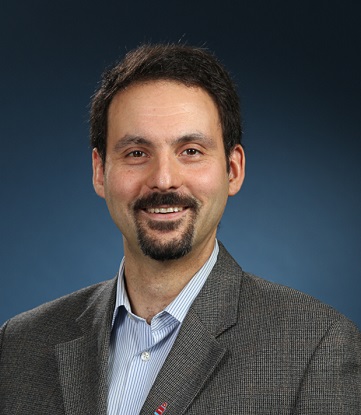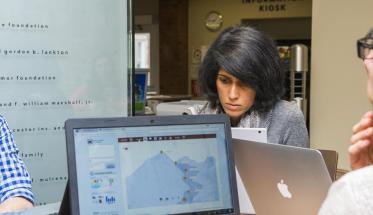In an effort to meet the changing education needs of both students and professionals, WPI is piloting an online program initiative as part of the Strategic Plan that allows students to complete classes at their own pace, proving their competency in a particular subject area as they go. Known variably as competency-based education or personalized online education (POE), the approach is lauded for its flexibility.
POEs consist of a series of modules (approximately 10 to 14 per course), with each module focusing on a particular subject or competency. As students complete each module, they must prove their competency before progressing to the next module. The flexibility in time and in ways to prove a competency makes the program especially appealing to students who aren’t always able to commit to a set class schedule or timeline.

Stephen Flavin
WPI’s pilot program in systems engineering helped debut the POE concept in 2016; a new pilot in autonomous vehicles is slated to launch later this year.
With the advent of POE at WPI, the university hopes to open up more opportunities to students and potential students. “We have lowered the barriers and relaxed the time requirements,” says Stephen Flavin, vice president of academic and corporate engagement, who is co-leading the initiative with David Cyganski, professor of electrical and computer engineering. Mindful that the typical POE student is likely a working professional who is getting a master’s degree in order to advance at his or her job, Flavin notes how important the flexibility is. The modules, despite being accommodating to varying time constraints, are no less rigorous.
POEs also give more people more opportunities for success because of the nature of the timing and of the varied testing styles available. “The tenet is that you move at your own pace,” says Stacy Chiaramonte, director of online programs and corporate operations at WPI’s Corporate and Professional Education, “and everyone is moving at different time lines. There are different pathways based on an individual’s needs.” Students, all at the graduate level, generally complete the work at their own pace–logging in whenever they have the time.
While any course needs to be completed in a set amount of time (typically graduate classes must be completed in 10 weeks), POE students are allowed an additional 6 to 8 weeks to complete a course. Motivated students can complete course requirements much faster, and those who are especially pressed for time and who choose POE for flexibility can take the full amount of time. How to prove a student’s competency in each module is up to the student and the professor. Students often can choose from many options—taking an exam, writing a paper, making a presentation, completing a project—to reflect the module’s concepts.

Stacy Chiaramonte
WPI plans to launch a POE course in autonomous vehicles and will use approaches learned during the systems engineering pilot courses to make the process more streamlined and beneficial, says Chiaramonte. The systems engineering course reflects interest in one of the biggest traditional online programs at WPI and one in which there is already excellent student-to-student interaction (especially important for an online program) and student-to-faculty interaction.
“This is all about educating students and President Leshin’s vision for being a global polytechnic,” says Chiaramonte. “We are increasing access to education and providing targeted learning.” But, in providing POE, WPI is also appreciating that students today are consumers and can get an education where they see the best fit; this option provides one more choice and that reflects WPI’s cutting-edge and innovative approach to education. “This is part of the WPI focus on continually challenging ourselves to be better innovators and stay on the cutting edge,” she says.
Converting courses to POE takes time and a different approach, Flavin says, as the actual planning tactic needs to look at multiple courses from a program level, not a course level. At the program level, faculty and staff can determine what modules are most effective and how those modules can be divided, combined, or structured. As the course modules develop, faculty members can collaborate on modules or independently on separate modules that will together become one cohesive course. And faculty members can also pull in various metrics or tests within a course to make sure the students are working on track, says Chiaramonte. With a short quiz, a poll, and discussion board participation, faculty members can determine if a student is struggling. Students can even take targeted modules, rather than completing the full course, for immediate learning that’s required on the job.

Alex Wyglinski
Associate professor of electrical and computer engineering Alex Wyglinski says the topic of autonomous vehicles alone is cutting-edge, but to combine it with a POE approach is nothing short of revolutionary. “This area is a high-growth area,” says Wyglinski. “Not many people know what autonomous vehicles are all about and people are trying to catch up. Few are offering educational opportunities to learn about this, and no one is developing a curriculum that centers on understanding this like this is.”
Students in POE will have a chance to complete a full set of modules for a course, says Wyglinski, but they might just choose to become competent in one or two modules as needed for their work. The innovative approach combined with such an emerging area is revolutionary, he says, because it delivers much-needed and current content in a rapidly developing field. “The timing is great and the time is now,” he says. “I am hoping we can become one of the thought leaders.”
One of the techniques with POE, says Chiaramonte, is choosing how to overlap modules that might be so similar they can be considered one module. By doing so, the process is even more streamlined for faculty, who don’t have to develop two modules when there could be one, and for students who won’t have to take an extra and similar module.
Reflecting on and keeping with WPI’s tradition of hands-on project work, Chiaramonte says the modules can be grouped to allow for both independent coursework and project work. “The long-term vision is that students would complete the independent modules at their own pace and then join a team for a more structured project module or course,” she says. “This allows students to move at their own pace for the modules where that makes sense while supporting the project work that is such an important aspect of the WPI programs.”
- By Julia Quinn-Szcesuil




